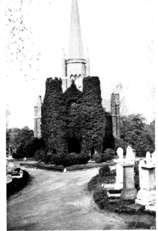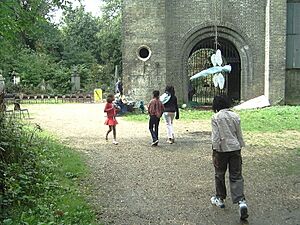Abney Park Chapel facts for kids
Quick facts for kids Abney Park Chapel |
|
|---|---|

The dramatically soaring Abney Park Chapel
|
|
| Country | England |
| Denomination | Nondenominational |
| History | |
| Founded | 1838–40 |
| Founder(s) | George Collison |
| Architecture | |
| Architect(s) | William Hosking |
The Abney Park Chapel is a special building in London, England. It's a chapel located inside Abney Park Cemetery, which was the first cemetery in Europe that welcomed people of all faiths.
The chapel was designed by William Hosking and built by John Jay. It opened in May 1840. This made it the very first nondenominational cemetery chapel in Europe. It also helped start a new style of building called Dissenting Gothic.
A small team worked on the chapel's design. This included George Collison II, who was passionate about creating a unique cemetery. William Hosking was the architect, and John Jay was the builder. George Loddiges, a plant expert, helped plan the chapel's beautiful garden setting. The first minister of the chapel was Reverend John Jefferson.
Contents
Where is the Chapel Located?
The designers wanted the chapel to be special. They decided to put it right in the middle of Abney Park Cemetery. This was different from other cemeteries that usually placed chapels near the entrance.
The idea was that as visitors walked along the winding path called Chapel Ride, the chapel would slowly appear through the trees. Bhutan Pine trees were planted along this path to create a beautiful, natural view. This way, the chapel would not overshadow the cemetery's main entrance, which had an Egyptian-style design.
Even though it was in the center, the chapel was meant to be seen from far away. It needed to be tall and noticeable. Hosking decided a tall steeple was the best way to achieve this. It was designed to be taller than any other steeple nearby, making it a clear landmark.
A Mix of Building Styles
The chapel was designed to show a message of religious harmony. It combined traditional and unique features. William Hosking worked hard to create an elegant design. He started with a common Anglican Gothic church style and then changed it.
This was a bit unusual because many nonconformists (people who weren't part of the main church) usually preferred classical designs, not Gothic. Later, the Gothic style became more popular with nonconformists because they liked its look.
However, when Abney Park Chapel was designed (1838–1840), using Gothic style often made people think of "high church" buildings. Some people believe Hosking and Collison used Gothic to balance the cemetery's Egyptian-style entrance. This showed the cemetery's idea of welcoming everyone, no matter their faith. It also honored Isaac Watts, a famous hymn writer who lived on the land a century before.
Later, in the Victorian period, Gothic designs also started to be linked with nature. This might have influenced Hosking's design, as the cemetery was planned to be a huge botanical garden with the largest tree collection in the country, thanks to George Loddiges.
Abney Park Chapel is thought to be one of the earliest examples of Gothic Revival architecture for a stand-alone chapel that wasn't tied to a specific church. Hosking and his clients wanted to create a "low Gothic" style. This meant it was simpler and less fancy than some other Gothic buildings. For example, they used regular brick instead of expensive stone for much of the outside.
They also added classical features, like rounded arches, to the carriage entrance. Each viewing tower had a simple round window, not a pointed Gothic one. This mix of styles was rare in England at the time. It connected the chapel to older European religious buildings where different cultures lived together.
Hosking also carefully designed the chapel's three rose windows. These windows might have been inspired by a church in the Czech Republic that has a rare ten-part rose window. Wild roses naturally have five or ten petals. Using a "botanical" rose window added a touch of science and nature. This would have pleased George Loddiges, the botanist on the design team, who saw beauty in nature's designs. He even created a special rose garden near the chapel.
For the pointed Gothic windows, Hosking kept them simple without extra decorations. For the steeple, he looked to the tall, elegant steeple of Bloxham church in Oxfordshire. He added colorful bands to the steeple, which was a popular style at the time.
The final chapel had plain yellow brick walls, a tall and graceful steeple, and simple, nature-inspired rose windows. It looked dramatic but also tasteful and served its purpose well. It became a landmark visible from nearby streets.
A Single Room for Everyone
The chapel's design was carefully planned to meet the cemetery directors' wishes for a new nondenominational style. William Hosking did an excellent job.
What was also very important was the chapel's inside layout. It had only one main room, open to everyone, no matter their faith. This made it the first nondenominational cemetery chapel in Europe in a practical way, not just in its look. Its floor plan was shaped like a Greek cross, with equal arms. This design also showed the idea of equality for all people before God. At a time when cemeteries usually had separate chapels for different faiths, or at best, two rooms, Hosking's chapel was truly unique.
Honoring Isaac Watts
The chapel's design avoided being too overly decorated. By choosing a "low Gothic" style, William Hosking made sure people would notice the chapel's most decorated side – the south side. This side had a fancy top and was between two round stair towers. These towers had simple round windows and led to great views over Dr. Watts' Walk. This created a beautiful background for the south chapel lawn.
The chapel was purposely lined up with a new path called Dr. Watts' Walk. This path led to where Dr. Watts and Lady Mary Abney used to live. This alignment was important because it showed how the cemetery company wanted to honor Dr. Watts.
Dr. Watts was a very important person to the cemetery founders. He was known for being open to all faiths. Even though he was a religious Independent, he was honored with a memorial in Westminster Abbey. His hymns and teachings were popular with many different religious groups. Later, a public statue of Dr. Isaac Watts was placed in Dr. Watts' Walk, right in front of the Abney Park Chapel.
The Chapel Today
Today, Hosking's unique chapel is still admired as a beautiful and important building. It stands out among the Magnificent Seven London garden cemeteries and across Europe. It also played a big part in the history of nondenominational cemeteries, being the first to have a chapel open to all faiths.
However, a fire damaged the inside of the chapel, and it has been closed for many years. The roof has also been damaged by climbing and theft, causing water to leak into the walls. The chapel is still considered a "building at risk," even after some repairs. The Abney Park Cemetery Trust is working on plans to reopen it and allow the public and community groups to use it again, along with improving the surrounding nature and landscape.



